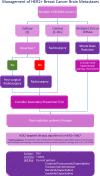HER2-positive breast cancer brain metastasis: A new and exciting landscape
- PMID: 32881421
- PMCID: PMC9124511
- DOI: 10.1002/cnr2.1274
HER2-positive breast cancer brain metastasis: A new and exciting landscape
Abstract
Background: Brain metastases (BrM) incidence is 25% to 50% in women with advanced human epidermal growth factor receptor 2 (HER2)-positive breast cancer. Radiation and surgery are currently the main local treatment approaches for central nervous system (CNS) metastases. Systemic anti-HER2 therapy following a diagnosis of BrM improves outcomes. Previous preclinical data has helped elucidate HER2 brain trophism, the blood-brain/blood-tumor barrier(s), and the brain tumor microenvironment, all of which can lead to development of novel therapeutic options.
Recent findings: Several anti-HER2 agents are currently available and reviewed here, some of which have recently shown promising effects in BrM patients, specifically. New strategies driven by and focusing on brain metastasis-specific genomics, immunotherapy, and preventive strategies have shown promising results and are under development.
Conclusions: The field of HER2+ breast cancer, particularly for BrM, continues to evolve as new therapeutic strategies show promising results in recent clinical trials. Increasing inclusion of patients with BrM in clinical studies, and a focus on assessing their outcomes both intracranially and extracranially, is changing the landscape for patients with HER2+ CNS metastases by demonstrating the ability of newer agents to improve outcomes.
Keywords: CNS involvement; HER2-positive breast cancer; T-DM1; brain metastasis; trastuzumab; tucatinib.
© 2020 The Authors. Cancer Reports published by Wiley Periodicals LLC.
Conflict of interest statement
C. K. A.: Research funding PUMA, Lilly, Merck, Seattle Genetics, Nektar, Tesaro, G1‐Therapeutics; Compensated consultant role: Genentech, Eisai, IPSEN, Seattle Genetics; Astra Zeneca; Royalties: UpToDate, Jones and Bartlett.
The other authors have no conflicts requiring disclosure.
Figures

References
-
- Siegel RL, Miller KD, Jemal A. Cancer statistics, 2020. Ca‐Cancer J Clin. 2020;70(1):7‐30. - PubMed
-
- Barnholtz‐Sloan JS, Sloan AE, Davis FG, Vigneau FD, Lai P, Sawaya RE. Incidence proportions of brain metastases in patients diagnosed (1973 to 2001) in the metropolitan Detroit cancer surveillance system. J Clin Oncol. 2004;22(14):2865‐2872. - PubMed
-
- Lin NU, Bellon JR, Winer EP. CNS metastases in breast cancer. J Clin Oncol. 2004;22(17):3608‐3617. - PubMed
-
- Tsukada Y, Fouad A, Pickren JW, Lane WW. Central nervous‐system metastasis from breast‐carcinoma‐autopsy study. Cancers. 1983;52(12):2349‐2354. - PubMed
-
- Arvold ND, Oh KS, Niemierko A, et al. Brain metastases after breast‐conserving therapy and systemic therapy: incidence and characteristics by biologic subtype. Breast Cancer Res Treat. 2012;136(1):153‐160. - PubMed
Publication types
MeSH terms
LinkOut - more resources
Full Text Sources
Medical
Research Materials
Miscellaneous

